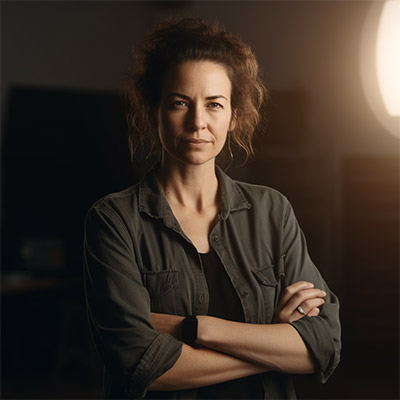
Hairdresser
Will AI replace Hairdressers?
The prospect of a robotic hairdresser might seem like an episode out of a futuristic science fiction movie, but it is likely to remain just that (fiction) for many years.
Despite the remarkable developments that AI has been making of late, and the very real threat to many jobs, some sectors will remain stubbornly out of reach for a long time to come. The job of hairdresser is one of them.
At some point, highly advanced humanoid robots, powered by AI, will undoubtedly be able to cut hair, and do a good job of it. This article explores the likely timeframe for that, and other factors of interest to hairdressers who are worried about AI.
The History of Hairdressing
The origins of hairdressing can be traced back to the earliest civilizations. Pharaohs had hairdressers, and so did the nobility of ancient Greece and Rome. Fast forward a few thousand years to the 18th century, and French hairdressers were crafting extravagant hairstyles that were as much a testament to their artistry as their clients' social standing. Hairdressing has always been more than a 'mechanical' task.
The history of trying to automate hairdressing is extensive too, with patents reaching back to the late 1800's. The abject failure of practically all of these inventions commercially is perhaps best characterized in the 1968 movie 'Chitty Chitty Bang Bang', where the lead character Caractacus Potts, played by Dick Van Dyke, creates a bike-powered hair cutting machine which malfunctions, and leads to him being chased by its unfortunate victim.
Perhaps the one exception is the Flowbee, a somewhat successful automated haircutting system which uses a vacuum powered haircutting technique, popularized through TV shopping networks starting in the late 80's, that is somewhat incredulously still available to this day. (It's not very good though).
Technological Factors - Why AI will struggle with Haircuts
To understand the potential threat to hairdressers from AI, we really need to explore the technological challenges that automating hairdressing presents. There are numerous reasons why even with profound advancements in AI and robotics, replacing human hairdressers is a really tough technological challenge.
Sensory Limitations
Hairdressing requires a fine-tuned sensory perception, honed over years of haircuts and experience, that make it arguably one of the toughest challenges for robotics to replicate. Nearly all of us have experienced sitting in the chair of a really great hairdresser, as they work their magic around our hair at rapid pace.
I'm the first to admit I'm far from an expert on hairdressing, but I know robotics and software well, and have had a few haircuts, and the dexterity, sensory 'feel' and experience required to 'simply cut hair' is frankly mind blowing. The art of moving, exploring and feeling the way through the hair, understanding its texture (which of course varies greatly between people), knowing how much and where to cut, and adjusting technique based on the feedback your fingers provide, is all highly advanced. The haptic technology of today and the foreseeable future, simply isn't anywhere near advanced enough to replicate this level of tactile perception.
The 3D Challenge
Creating a hairstyle isn't a 2D job. It involves working around the (infinitely) variable shape of a human head, dealing with different hair densities, lengths, and textures, all while keeping in mind the intended style and how to get there. It's a multi-layered, 3D puzzle. For an AI-powered robot to replicate this, it would need to overcome substantial challenges in spatial perception, dexterity, and precise movement control. While robotics have and will soon make much faster progress, we're a long way from the required finesse and adaptability to automate this to anything approaching the skill of a professional hairdresser.
Real-Time Error Correction
Hairdressers don't simply evaluate what needs to be done at the start, and proceed along blindly - they are constantly assessing and re-assessing their work as they go. They lift, examine, inspect... and adapt. If a hairdresser makes a wrong snip, they are able to see the problem and adjust the haircut on the fly. This requires an innate understanding of the process, extreme vision capability (from a technological perspective), understanding of the end goal, and the creative possibilities to adapt as needed. In contrast, AI operates based on trained data and algorithms, and will struggle to see these issues and improvise creatively in response.
Safety, Dexterity and Tools
Operating a sharp pair of scissors around someone's face is a risky proposition even for human hairdressers, let alone robots. Most of us will have experienced a painful mistake by a hairdresser at some point in our lives, perhaps even drawing blood, but the reality is these issues are few and far between. And that comes from the experience and visual acuity of a hairdresser. The dexterity to operate scissors around people's heads is also extreme, not to mention the need to use many different types of tools interchangeably - blending shears (for texturizing or thinning), paddle brushes, a blow dryer, curling iron, sectioning clips, foil, spray bottle, mirror, and even the lowly apron - every one of these 'tools' adds insane levels of technological complexity to the challenge of trying to automate hairdressing by a robot.
The Complexity of Aesthetics
Moving on from the pure technological challenges, which are many, a crucial part of hairdressing is the understanding and interpretation of human aesthetics - a skill that's rooted in subjectivity, humanity and nuance. Yes AI could be trained to understand symmetry and geometric precision, but can it discern why one hairstyle would better suit a person's personality over another's?
Could it judge whether a brunette color tone should carry more chestnut or mahogany hues, to complement someone's complexion?
Not easily.
A good hairdresser can take one look at a person and instantly see what will work for that person. Not only this, but they can communicate with the person - and frankly people who struggle to communicate in the right technical terms - and figure out an understanding (through dialogue) of what the person wants.
This is a highly complex challenge for AI.
The Art of Conversation
It's true there are many people who prefer a 'conversation-free' haircut, but it's also true there are many others who look forward to their cosy chats with the hairdresser. For many, a rapport is built over countless haircuts and years, or even decades. Hairdressers in this sense act as confidants, therapists, advisors - all while they're beautifying your looks.
They listen, empathize, and sometimes offer a much-needed pep talk. That's a tall order for AI, which, despite major strides in natural language processing, struggles with context, humor, and the intricacies of human emotion. This last aspect will undoubtedly change, and I have no doubt that within 10-15 years we'll all be chatting away with humanoid robots as if they're people, but for a non-zero percentage of the public, such people will always prefer the reality of chatting with a real-life human.
The aspect of cost
In the context of our outgoings and expenses, haircuts are not particularly expensive - indeed you can spend more on a round of drinks for friends. This has two important effects. Firstly, there is very little commercial imperative to switch things up, particularly when you consider that many hairdressers are paid on commission i.e. per hair cut.
Secondly, the cost of a highly advanced humanoid robot, capable of doing all of the various tasks of a hairdresser, will be astronomically high ($500k-1 million?) for many years after their introduction. So even when such a robot becomes available, and when you factor in the cost of maintenance, it will make very little commercial sense for a salon to purchase them, at least until such time as the cost comes down to less than say $100,000 in today's money.
Furthermore, it's unlikely a general purpose humanoid robot will be up to the task of hairdressing for 2-3 decades, and the market for a specialized hairdressing robot will not be an attractive candidate for manufacturers, for the reasons cited, when far easier and more profitable opportunities await.
Summary
The technological challenge of creating a hairdressing robot is extreme. As I've written in several other articles on this site, people who work with their hands are generally far better protected from advancements in AI, compared to knowledge workers.
As Leonardo da Vinci said, "Simplicity is the ultimate sophistication". While AI is redefining complexity, it is the simple, seemingly straightforward jobs like hairdressing, where human creativity, empathy, dexterity and intuition win out.
There will undoubtedly be media headlines (and examples) of robot powered hairdressers, as for some reason (most likely those who don't like visiting the hairdresser), these seem to touch on an interest in people, but the reality is, such pronouncements will be nothing more than headlines, experiments.
AI will offer incredible options for 'visualization' within hair salons. Take a photo, run it through AI, see hyper-realistic variations on styles and options that you can discuss with your hairdresser. These will likely become standard in salons within 10 years.
But a human hairdresser will be the one to make the cut, and fundamentally the job of hairdresser is safe from AI - for a very long time to come.
Conclusion: Extremely Safe | Time Period: 30-40 Years


